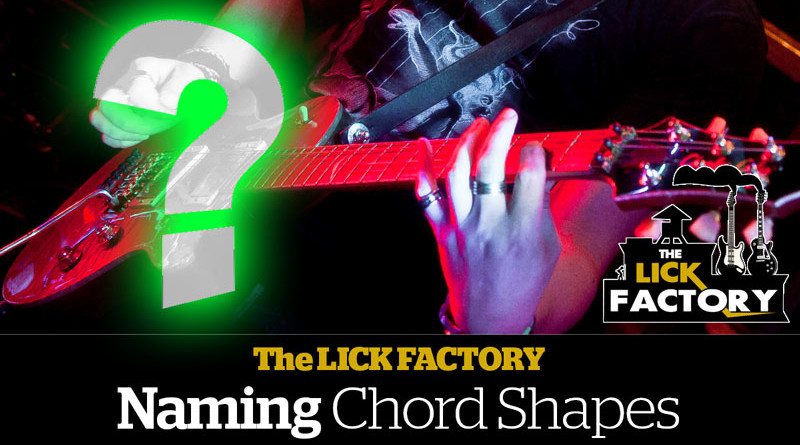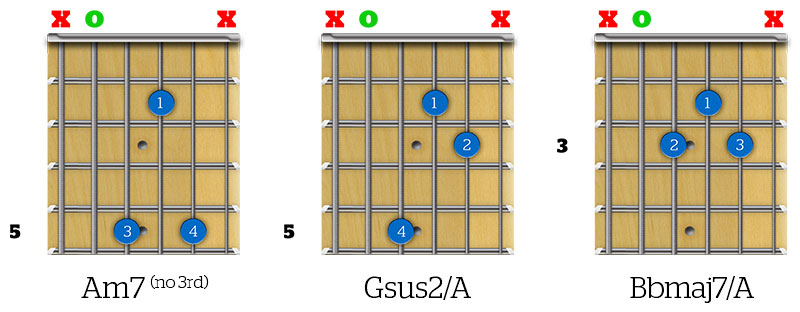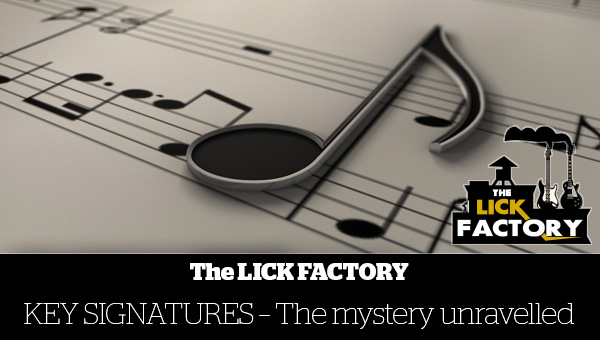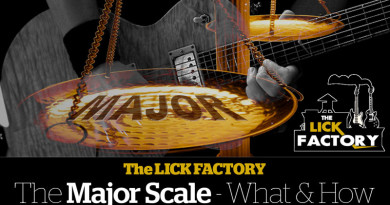Naming Chords
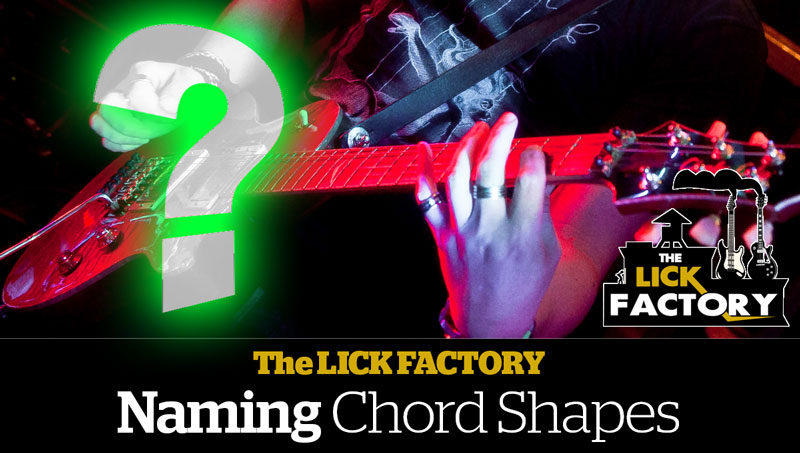
What’s in a name? When it comes to naming chords, its nothing more than your thought process and theoretical perspective. You have 6 strings, up to 24 frets and a mind boggling amount of note combinations, and every single one of them has to be called something!
Naming Chords – Why?
You might consider naming chords a useless venture. At the end of the day if the note combinations sound good and you know where to put your fingers, then what’s the point. I’d retort this argument with another question. How would you teach someone else to play the perfect chord shape for one of your songs if you if:
While you can accomplish these scenarios without ever naming a chord, you would probably already be familiar with the fact that calling out an “A” across the stage or rehearsal room makes life a lot simpler.
So lets have a look at how a simple shift in perspective can dramatically alter how you are naming chords. We’ll begin by looking at a simple C Major triad.
Naming Chords – How?
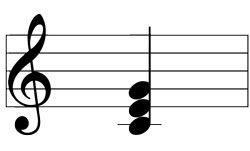
The C Major chord has the 1st note, the 3rd note and the 5th note of the major scale in it, thus the name C Major. (you can read more about the major scale here.)
We’re looking at this chord from the C perspective. Given this is the easiest way to get the combination of notes you require, but lets explore some other naming options.
If we shift our focus to name the chord from the E, we would compare the three notes; C, E, and G to the E major scale. From this point of view the E would be the 1st. The G would be the b3rd, and the C would be the b6th. So this chord could be named Emb6/C. The “/C” is included in the name because the lowest note or bass note of the chord remains to be the C.
You might ask yourself, why is there no 5th? When it comes to playing chords, especially in a jazz scenario, one of the first things you learn is that the 5th can be omitted from a chord without sacrificing the overall tonality of the chord. The role of the 5th is to add support and strengthen the sound of the root note with the perfect 5th interval. This is the reason that the rock ‘power chord’ only contains the 1st and 5th notes.
In this context we would need to amend the chord name to reflect the fact that we have not included the 5th (B in this case) within the shape. This is achieved by simply making a note in brackets after the name of the chord.
Emb6/C(no5th)
Now lets shift our perspective again to treat the G as the tonic. In this case the G would be the 1st, the C is the 4th and the E is the major 6th. Once again, we will have no 5th in the chord so you would be required to reflect this at the end of the chords name. The other elements are the 4th and the 6th. Starting with the 6, we would have G6. The substitution of the 4th for the 3rd indicates that the chord is a suspended 4th. Adding that to the name we have G6 sus4. Like the previous chord, we still have the C as the lowest note of the chord which should be displayed as “/C”. Finally adding the “(no 5th)” to the chord name, we end up with:
G6 sus4/C (no 5th)
To recap, our 3 chord names for the same three-note triad are:
Looking at these names, it’s not hard to see why C is the preferred option.
Naming Chords – Application
So how would you apply this concept when naming chords that are based around a shape you have come up with rather than written notation. To put it simply, its pretty much the same process with the addition of working out the notes you’re using first.
In a previous tutorial on pedal tones, we looked at a chord progression to one of my instrumental tunes called ‘The Heights”. This progression follows a string of arpegiated chord shapes using the A as a pedal tone. This progression is a great example of naming chords as the progression itself was written with no chord shapes in mind at all. Each of the 3 chords were written to complement each other while also giving me the options I wanted to write the melody over the top in multiple keys.
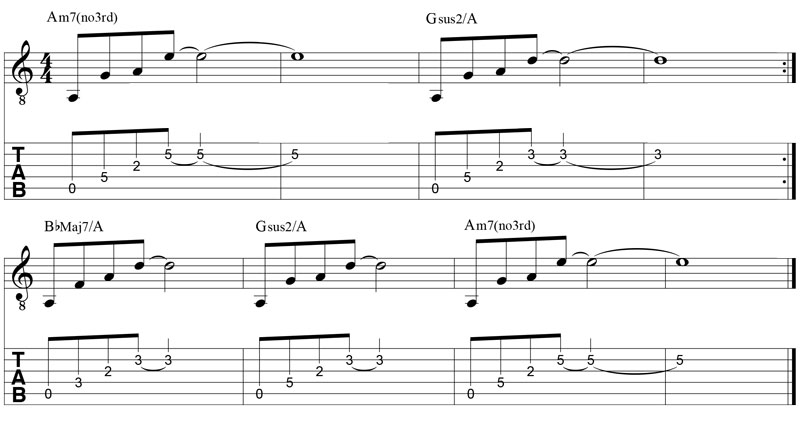
The three chord shapes used in the progression are as follows.
With these three shapes in mind, lets look at how the above process assisted me in naming the chords. Starting with the first shape, the notes that appear in the chord in order are: A, G, A, E.
Step 1 is identifying the bass note or the lowest sounding note of the chord. This is the A.
Step 2 is eliminating any duplicate notes leaving us with the bare minimum notes. A, G, E
Step 3: work out the chord names options treating each individual note as the tonic.
Step4: Choose and commit the name.
With the 2nd chord of the progression, the notes are A, G, D. Following the same steps the chords I ended up with were: Am7sus4, Gsus2/A and Dsus4/A. Of the 3 chord names , the Gsus2/A best suited my purpose.
The third chord has A, F and D. Once again following the steps for naming chords, we end up with three names. Dminor/A, Bbmaj7/A and A6sus4(no5th). Of the 3, I opted for the Bbmaj7/A.
This article touches on concepts from the LICK FACTORY’s Set 1 and Set 2 courses. Bring your chord playing up to a completely new level.
Need a quicker fix? the ULTIMATE CHORD GUIDE: Volume 1 might be the answer.
Who’s your Teacher?
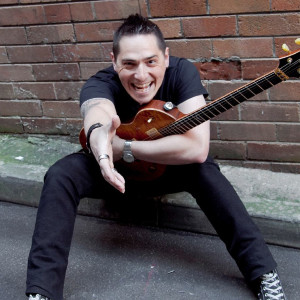
Kris Petersen is a name that has become synonymous with the Australian Music Industry. From clubs to stadiums, Kris has performed on every continent in the world and shared the stage with some of the world’s greatest artists.
In the last few years alone, Kris has performed with, or alongside Alice Cooper, Aerosmith, Orianthi, Van Halen, Billy Joel, Matt Sorumn (Guns n Roses), Eric Martin (Mr. Big), The Drifters, Tony MacAlpine, Buckcherry, Daryl Braithwaite, The Living End, Icehouse, Marcia Hines, The Screaming Jets, The Choirboys, Mental As Anything, Bruce Kulick (KISS), Leo Sayer, Pretty Boy Floyd and many more… read more

